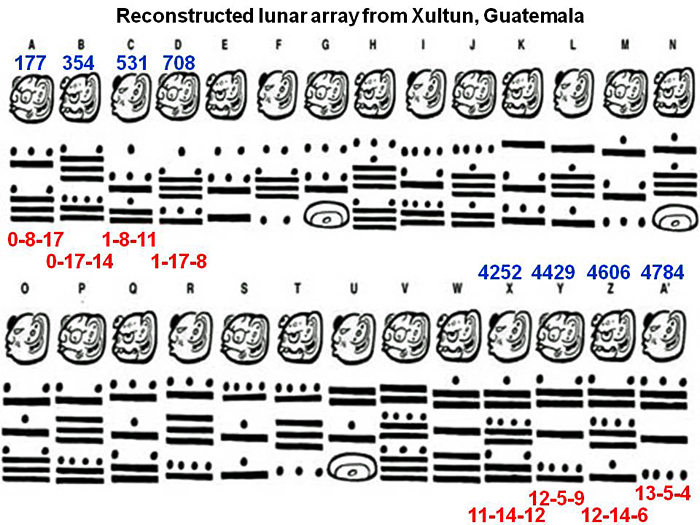- Reminder: turn off your rectangles!
- Your assignment is returned:
- Jesie Smith -- nice table
- You have an assignment to turn in: your Mayan tables.

I've brought in The Universal History of Numbers, by George Ifrah, so that you can appreciate all the work that's been done that we don't have a chance to discuss.
"It is even more puzzling that the Maya measurements were done without any tools to speak of. They had not discovered glass, so there were no optical instruments. They had no clockwork, no hour-glasses, no idea of water-clocks, no means at all of measuring time in units less than a day (such as hours, minutes, seconds, etc.); nor did they have any concept of fractions. It is hard to imagine how to measure time without at least basic measuring devices." (p. 298).
We started last time with some simple examples, and we should do a warmup: what's 223*67
| 1 | 223 | |
| 2 | ||
| 4 | ||
| 8 | ||
| 16 | ||
| 32 | ||
| 64 | ||
| 128 | Too big! |
On the left we build the "missing part" of the product -- 67 -- and on the right we build up our answer, using the corresponding doubles of 223.
Examples: Try these as a warmup (we'll be using them in a division problem in a moment).
- 43*22 (= 946)
- 21*79 (= 1659)
We can think of this as a product instead:
For the product we'd take one of the parts of the product (the divisor, say), and double it on the right. Making up the quotient with numbers on the left, we'd then find the dividend by adding up the corresponding numbers on the right.
In the division problem we know the dividend, so we reverse the process: we find numbers on the right that sum to the dividend, and then add up the corresponding numbers on the left to give the quotient, which is what we're after.
Examples: Try these (we'll just reverse the problems above, to show how we're using the table backwards).
- 946/43 (= 22)
- 1659/21 (= 79)
- When the denominator doesn't divide the numerator
evenly, fractions make it more interesting:
Let's look at an example: divide 35 by 8.
In a way we turn it into a multiplication problem: what times 8 equals 35? So we know the 8, and use it to "double" -- but then to "halve", when 8 won't go evenly into 35:
1 8 2 16 4 32 * 1/2 4 1/4 2 * 1/8 1 * So the answer is 4+1/4+1/8
- the Egyptians restricted
themselves to the so-called "unit fractions", which are
fractions of the form 1/m:
unit
fraction table, which is found on the Rhind
Papyrus (which dates to around 1650 BCE).
But they didn't restrict themselves to "halving", as our next example shows. Divide 6 by 7:
1 7 1/2 3+1/2 * 1/4 1+1/2+1/4 * 1/7 1 1/14 1/2 * 1/28 1/4 * So the answer is 1/2+1/4+1/14+1/28
Notice that the Egyptians didn't use decimals -- you shouldn't either!
Why did Egyptians do things this way? (an example division problem, 3/5)
Dominic Olivastro, "Ancient Puzzles", suggests a third reason why this use of unary fractions is good. Consider the problem Ahmes poses of dividing 3 loaves of bread between 5 people. We would answer "each person gets 3/5-ths of a loaf". If we implemented our solution, we might then cut 2 loaves into 3/5 | 2/5 pieces, with bread for 3 people; then cut one of the smaller pieces in half, giving the other two people 2/5 + 1/5 pieces. Mathematically acceptable, but try this with kids and they will insist that it is not an even division. Some have larger pieces, some have smaller. Ahmes would calculate 3/5 as : 3/5 = ()3 + ()5 + ()15 [ = 1/3 + 1/5 + 1/15 ] Now cut one loaf into fifths, cut two more into thirds, then take one of the 1/3-rd pieces and cut it into 5-ths (for the 1/15-th pieces), and you can now distribute everyone's 3/5-ths share in a way that _looks_ equal, since they will have exactly the same size pieces. (And no, I don't want to argue about the crust.)
- There is another way to get these answers, using
the Fraudini trick and the unit fractions table. So
let's try those same examples but using the unit
fraction table rather than our doubling tables.
- 35/8
- 6/7
- Here's a relatively easy one: Suppose Fatima had 3
loaves to share between 4 people. How would she do it?
(Think about what the answer means, in terms of bread.)
- A little trickier:
- How would you divide 5 by 7?
- How can we use the unit fraction table to get the same answer?
- How would you like to do story problems like this one?!